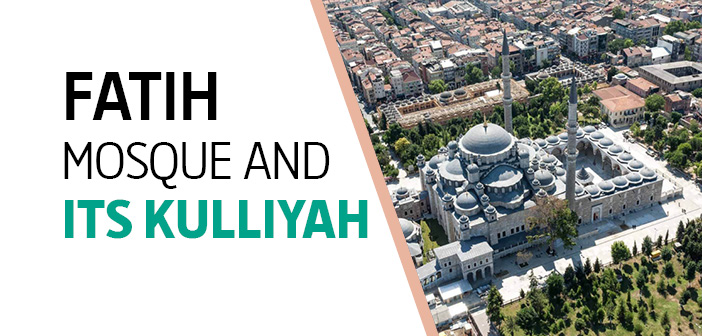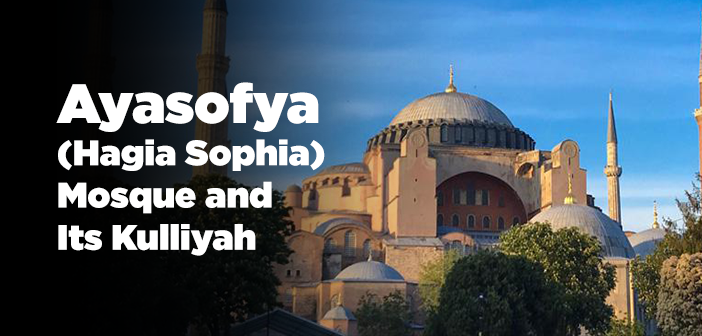Where is the fatih mosque? What does the fatih mosque and kulliyah include?
“For we do not have an architectural literature and history and because of some complex narrations, we vaguely know our honorable architects like old Sinan, Ayas, Hayreddin, Kemaleddin. Our ancestors did know how to construct ingeniously buildings not just in architecture but in every field; however, they forgot to write about them. This is our tragic misfortune. (Yahya Kemal Beyatlı, Aziz İstanbul, p.57)”
Fatih Mosque is one of the kulliyahs that gave their names to the districts in which they are located.
It was constructed in between 1463 and 1470 by architect Atik (freed slave) Sinan upon the command of Sultan Mehmed II. The Kulliyah of Fatih Mosque is the biggest structure compared with the ones built until its time. At the same time, it is one of the most significant pieces of Turkish-Islamic architecture of the classical period.
The Kulliyah of Fatih is a perfect one with its madrasas, library, guesthouse, caravansary, bazaar, hospital, and bathhouse.
The mosque has been established on ruins of a church which belongs Byzantine period.
Unfortunately, the mosque constructed by Sultan Mehmed II could not survive to our day for it was heavily damaged by the earthquakes of Istanbul. The first mosque was repaired after it had been substantially damaged during the great earthquake in 1509. It was heavily damaged once more during the earthquakes in 1557 and 1754. In the 1766 earthquake, its dome was completely collapsed and the walls were damaged so much so that it could not been repaired. It was reconstructed by Sultan Mustafa III in 1767. This new Fatih Mosque was built by the Architect Mehmet Tahir.
Even though Fatih Mosque is a building from classical period, one can see some baroque ornamentation in it coming from its reconstruction in 18th century.
The big dome (26 m in diameter) placed on four marble columns has been supported by four half domes. The porches and the shadirwan (water-tank with a fountain) in the inner courtyard of the mosque are the parts survived from the original mosque.
One of the most important parts of the Kulliyah is its madrasa. It is the basis of Istanbul University. According to the narrations, even the builder of the kulliyah of great Ottoman Sultan Fatih Sultan Mehmed wanted to be a student in this madrasa. For this purpose, he was tested by the teachers of the madrasa, and after he passed those tests, he got admitted to it as a student. To be honest, when we think about today’s educational system in which the wealthy get admission to any school they want, it is hard to believe that a sultan took a stiff examination in order to be a student in a school built by his orders.
Unfortunately, a part of this proverbial madrasa was pitilessly demolished because of the construction of Fevzi Pasha Street. Unfortunately, the structures of the guesthouse, the bazaar and the bathhouse attached to the kulliyah could not reach today, either.
There are three tombs built at the qiblah direction of the mosque. Sultan Mehmed II and his wife Gulbahar Hatun are buried in two of these tombs. In the other tomb mother of Sultan Mahmud II Nakshidil Sultan is buried.
He, Who Lives by the Sword Dies by the Sword!
Fatih Sultan Mehmed Khan, who ruled the Ottoman Empire between 1451 and 1481, conquered almost 200 castles, 14 states and 2 empires. He did not live even for three successive months in his palace constructed in the city conquered by him in 29 May 1453. Sultan Fatih lived his entire life running from one campaign to another on the saddle of a horse in the way of Allah. Again, he passed away when he was in a military campaign.
As the saying goes, he who lives by the sword dies by the sword.
There are two nice narrations related to Fatih Mosque. First, one is about Sultan Fatih, the first builder of the mosque.
The Sultan Who was defeated by the Justice
Sultan Fatih thought the mosque he was planning to build to be as enormous and majestic as Hagia Sophia was. Before he set out for a long campaign he met the Christian architect of the mosque, and asked him to build a huge temple. For this purpose, huge mono-blocks needed as pillars were provided. Soon afterwards the campaign was started.
Several months later when Fatih Sultan Mehmed Khan returned from the campaign, he learned that the Christian architect truncated the pillars and made them shorter. That mosque, whose construction was ongoing, was smaller than the Sultan wanted it to be. Thinking that the Christian architect built it intentionally smaller, the Sultan became so angry that he punished the architect by cutting his hands.
The architect thought that he was right. In order to get his due from the ruler he complained about him to the qadi (judge) of Istanbul.
Qadi Hizir Beg wrote a letter to summon Sultan Fatih to the court. According to customs of the state, his addressing to ruler was supposed to be like “al-Sultan ibn al-Sultan al-Ghazi Abu al-Fath Muhammed Khan-i Thani.” However, Hızır Beg’s addressing to the Sultan was like “Mehmed, the Son of Murad! Come to the court on such and such day, at such and such an hour!”
On day of the trial Sultan went to the court building in Uskudar and sat in the defendant’s chair. In the court, only the qadi could sit down during the trial, the plaintiff and the defendant could not. When Hızır Beg saw the sultan sitting, he warned him saying:
– You are here as an offender, stand up!
Upon this warning, Sultan stood up and defended himself standing. At the end of the trial Sultan was found guilty. In accordance with the verse of retaliation (qisas), qadi ruled that the sultan’s hands were to be cut in the same vein. In response to this verdict, Sultan said:
– Ruling belongs only to Allah.
Witnessing such a sense of justice, the bewildered Christian architect said to the qadi that:
– I give up my claim and accept the blood money (diyah).
After the matter was concluded in this way, Fatih said to Hızır Beg that:
– I congratulate you for you were afraid of Allah, not me.
Qadi Hızır Beg took out a mace under his pulpit and said that:
– If you had not accepted my decision, I would have crushed your head with this.
Sultan in return showed his sword hidden under his robe and said that:
– If you had not ruled justly, I would have beheaded you with this.
After the trial, Fatih gave to the Christian architect a house out of his own wealth. Thereupon the Christian architect said:
– “There is no equal of this level of justice in the world. From now on, I am a Muslim.” He said the statement of shahadah (or saying that there is no God but Allah, and Muhammad (pbuh) is His Messenger), converted to Islam, and he was honored with the true guidance. (Osman Nuri Topbaş, Tarihten Günümüze İbret Işıkkları, p.195-197)
The Sultan Who Had His Mosque Snatched
Sultan Mustafa III is one of the most beneficent Ottoman rulers. He is especially known with the mosques he constructed but did not name after himself.
First, Sultan Mustafa III had a mosque constructed in Uskudar. He had a school, a bathhouse and fountain built for this mosque that was opened to worship in 1761. Near the mosque there was a water-well regarded to be curative by the community. Such wells used to be called among the public as “Ayazma”. Because of this water well, the mosque started to be called “Ayazma Mosque”.
Thereafter, Sultan had one more mosque constructed in Aksaray. But this mosque started to be called “Laleli Mosque” because of a friend of Allah (awliya) named Laleli Baba living in the neighborhood of the mosque. Besides, modern day Laleli district has taken its name from there.
After Fatih Mosque was substantially damaged because of the earthquake, he nearly reconstructed the mosque from its foundations. However, this mosque was not named after Sultan Mustafa III, either. It continued to be called “Fatih Mosque” out of respect to its original constructer Fatih Sultan Mehmed II.
After all these, Sultan Mustafa III said that:
– I had three mosques constructed. All of them were gone to the others. One of them was taken by one of my ancestors and was named as Fatih Mosque. The other one was taken by a friend of Allah. People call it Laleli Mosque; and the last one was taken by the water. It became Ayazma Mosque.
Source: Harun Kırkıl, Read About and Travel Around ISTANBUL, Erkam Publications




